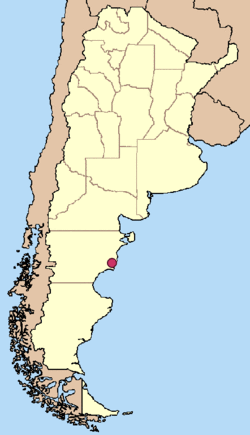Camarones (Chubut)
| Basic data | ||
|---|---|---|
| location | 44 ° 47 ′ S , 65 ° 42 ′ W | |
| Height above d. M .: | 10 m | |
| Population (2001): | 1079 | |
|
|
||
| administration | ||
| Province : |
|
|
| Department : | Florentino Ameghino | |
| Mayor: | Eugenio Héctor Rodríguez, Proyección Vecinal de Chubut | |
| Others | ||
| Postal code : | U9111 | |
| Telephone code: | 0297 | |
| map | ||

|
||
Camarones is a place in southern Argentina , located in the eastern province of Chubut on the Atlantic coast of Patagonia . It has 1,079 inhabitants (2001 census) and is the capital of the Florentino Ameghino department .
geography
Camarones is located in the Bahía de Camarones , a larger bay in the middle of an irregularly shaped coastal area, which is characterized by many peninsulas, bays, capes and small archipelagos such as the Islas Blancas off the coast . 30 kilometers to the south-east is Cape Dos Bahías , where the Reserva Natural Faunística Cabo Dos Bahías , a well-known nature reserve with abundant wildlife ( penguins , maned seals ) is located.
The climate is temperate, but windy and dry. There is about 200 millimeters of precipitation per year, especially in winter. The temperature in January is 19 ° C and in July 7 ° C. The Bahía de Camarones Bay is the southernmost point of the Atlantic coast of Argentina, which is influenced by the warm Brazilian current all year round and therefore has increased water temperatures (in summer up to 20 ° C).
history
Near Camarones, Simón de Alcazaba y Sotomayor founded the Spanish settlement "Puerto de los Leones" in 1535, which only existed for three months.
The place Camarones was founded in 1900. In the course of time it developed into the service center of the very sparsely populated surrounding region, where mainly sheep are kept. However, this branch of the economy fell into a deep crisis in the 1980s, which is why the residents are now trying to open up new job opportunities with alternative sources of income such as tourism and the commercialization of seafood.
A scandal erupted in the village in 2003 when a case of arson was discovered on a radio station that had broadcast critical reports on the administration of the local mayor.
Culture and sights
The architecture of the place consists mainly of houses made of corrugated iron and red bricks, which are reminiscent of times long past. There is a simple church built from boulders, an old general store worth seeing and a small tower ( torreón ), which is known as a lookout point.
The most famous event of the year is the Fiesta del Salmón (Salmon Festival) at the end of January, when fishing competitions and other events take place. Camarones describes itself as the Capital Nacional del Salmón , the "Capital of Salmon".
Economy and Infrastructure
economic sectors
The place lives from fishing and processing of algae. In addition, it is the service center for the surrounding estancias, where sheep are mainly kept. A certain type of wool ( tipo Camarones ) is named after the place. However, these traditional industries have been hit by a severe crisis since the 1980s, so Camarones now has high unemployment.
In order to persuade the younger residents to stay despite the poor labor market situation, the local school has been running a project for the commercialization of farmed marine animals since 1999, which was awarded an innovation prize in 2002 by the semi-state oil company YPF and today from several locations in South and Central America is imitated.
tourism
Since the 1980s, there has been some tourism in the area around the place, which is primarily related to the Cabo Dos Bahías nature reserve , which includes the second largest penguin colony in Argentina. In addition, there are several beaches between the village of Camarones and the Cape, which is about 30 kilometers southeast. In Caleta Sara , a bay near the cape, there are a few holiday colonies and leisure areas.
traffic
The connection to the Argentine transport network is via the paved Ruta Provincial 30, which connects the place with the important north-south connection Ruta Nacional 3 . Local public transport is sparse (buses to Garayalde on Ruta 3 and Trelew ). There is also a runway for small planes, which is rarely used.
